Best Nft Fantasy Football Download Database
Fantasy Football Information Assay with Python
Analyzing the human relationship between players' fantasy production and defenses
![]()
With the 2020–2021 NFL fantasy football flavour about to come to a close, I was inspired to analyze data from the past few years:
Before I outset jumping into the data assay, here's a summary of fantasy football game so we are all on the same page:
To play fantasy football, yous need to create or join a league on one of many websites (ESPN, Yahoo, Sleeper, CBS, NFL, etc). Each member of the league is the owner/general managing director of their team. Each league has two parts to a roster: the starting lineup and the bench. The starting lineup includes a combination of quarterbacks (QB), running Backs (RB), wide Receivers (WR), tight ends (TE), flexes (FLEX), kickers (Chiliad), and defenses (D/ST) based on league settings. The demote tin exist made up of any players the owner chooses.
There are three types of leagues:
- Redraft Leagues: each flavor, rosters completely reset and all players are available to draft
- Keeper Leagues: each flavour, owners can continue a certain number of players for the following flavor, and and so typhoon the rest of their roster
- Dynasty Leagues: each season, owners keep their unabridged roster for the next season and draft rookies in the draft
In that location are 2 types of drafts:
- Snake (Traditional) Drafts: each owner gets a chance to draft and the draft gild reverses each round of the typhoon
- Sale Draft: each owner gets a set amount of money, and each owner tin can bid for each actor as long as they have a sufficient corporeality of money
There are ii types of scoring systems:
- Standard: 1 bespeak per 25 passing yards, 4 points per passing touchdown, i point per 10 rushing or receiving yards, half-dozen points per rushing or receiving touchdown, -2 points per bollix lost or interception.
- Point Per Reception (PPR): Scoring is the same every bit Standard, except players get 1 additional indicate per reception
After the typhoon, you lot can add together unrostered players to your team or make trades with other owners to improve your team.
The start 13 weeks of the NFL season is known as the fantasy regular flavour, each week you play in a head to caput matchup with another owner in your league. Whoever has the most points scored by their players that week receives a win. Later the first 13 weeks, the owners with the most wins brand the playoffs and are placed into a bracket. After the fantasy playoffs (weeks 14–sixteen), the champion is crowned.
A vital function of fantasy football is deciding which players you lot are starting based on their matchups. Some players' output is heavily reliant on the force of the defense they play while others are "matchup-proof", meaning that regardless of the strength of the opposing team, they will perform well. I wanted to figure out which players were "matchup-proof" and which players were matchup reliant.
This led me to ask the question: what is the effect of a defense's strength on the fantasy output of a player?
Step #i: Information Collection
The commencement stride to any data analysis project is collecting the data. The data necessary is the yearly stats for every thespian, the weekly stats for every week for every player, the rankings of every defense force against QBs, RBs, WRs, and TEs, and the schedules for each squad from 2017–2019.
- Yearly & Weekly Stats: https://world wide web.fantasyfootballdatapros.com/csv_files
- Defense force Rankings: https://www.fantasypros.com/nfl/points-allowed.php?year=2018
- Schedules: https://www.4for4.com/teams/schedule/2017/filigree
Step #2: Calculating Fantasy Points
The side by side step is to iterate through all the data files and transform all of the stats into PPR fantasy points:
fantasypoints = 0 # negative stats fantasypoints -= (stats["FL"][i] * 2)
fantasypoints -= (stats["Int"][i] * two) # positive stats fantasypoints += (stats["PassingYds"][i] * 0.04
fantasypoints += (stats["PassingTD"][i] * 4)
fantasypoints += (stats["RushingYds"][i] * 0.one)
fantasypoints += (stats["RushingTD"][i] * 6)
fantasypoints += (stats["ReceivingYds"][i] * 0.1)
fantasypoints += (stats["ReceivingTD"][i] * 6)
fantasypoints += (stats["Rec"][i])
After converting player stats into fantasy points, the data files looked like:
Player Name, Position, Team, Games Played, Full Fantasy Points, Average Fantasy Points Todd Gurley,RB,LAR,15.0,383.iii,25.55
Le'Veon Bell,RB,PIT,15.0,341.6,22.77
Kareem Hunt,RB,KAN,sixteen.0,295.2,xviii.45
Alvin Kamara,RB,NOR,16.0,312.4,19.52
Stride #three: Pulling Defense Rankings for Each Week
One time, all the fantasy points were listed for each actor in the information files, I needed to pull the defense ranking of the team they played when they scored those points.
The rankings are determined by the average number of fantasy points a defense gives to each position (QB, RB, WR, TE) throughout the year. This means that each defence force has four unlike rankings:
Team, QB Rank, RB Rank, WR Rank, TE Rank ARI,18,4,18,14
ATL,23,vii,xiv,13
BAL,2,22,ii,21
BUF,5,32,5,22
To add together the ranking of the defense force to every weekly stat file, I had to iterate through all the weeks and all the schedule files to observe the opposing squad and so add together the ranking of the defence force to the weekly stat file.
One time added, the weekly files looked similar:
Player Name, Position, Squad, Total Fantasy Points, Opposing Team Rank Kirk Cousins,WAS,QB,26.viii,17
Tom Brady,NWE,QB,33.72,30
Jared Goff,LAR,QB,23.58,31
Case Keenum,MIN,QB,28.56,19
Step #4: Creating Correlation Coefficients and Graphs
Later the defensive rankings were added to the weekly files, all that was left to exercise was to iterate through all the weekly stat files and plot every histrion's fantasy points against the ranking of the defence they played:
plt.besprinkle(xdata, ydata)
plt.championship("Effect of Defence Strength on " + str(playername) + " in 2017")
plt.xlabel("Defense Ranking (one-32) | Correlation = " + str(correlation))
plt.ylabel("Fantasy Production Above/Below Yearly Mean") x = np.array(xdata)
y = np.assortment(ydata)
thousand, b = np.polyfit(x, y, 1)
plt.plot(x, m*x + b)
plt.plot(flatlinex, 0*flatlinex, linestyle = "--", dashes = (5, five), color = "black") plt.show()
Now all that was left to practise is it interpret the information that I compiled. But, before I share my findings, let me explicate the significance of a correlation coefficient.
A correlation coefficient (r) quantifies the force and management of a linear human relationship. A positive r indicates a positive linear relationship, and a negative r indicates a negative linear relationship. When r is greater than 0.6 or less than -0.6, information technology means that in that location is a strong correlation between the two variables.
Step #v: The Results
In that location were a few players each year that had a stiff correlation between their fantasy output and defense strength:
2017:
- Todd Gurley: 0.02 (#i Overall Player)
- Dak Prescott: 0.62
- Ezekiel Elliot: 0.64
- Alex Collins: 0.65
- Drew Brees: 0.65
- Charles Clay: 0.65
- Marlon Mack: 0.67
- OJ Howard: 0.68
- Male monarch Burkhead: 0.71
- Jared Goff: 0.85
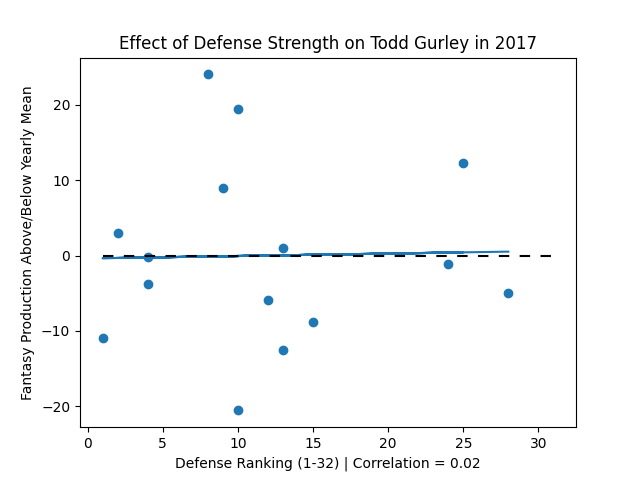
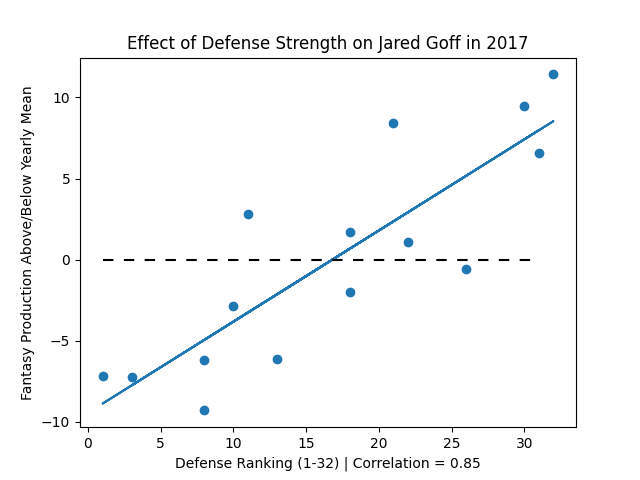
Todd Gurley was the highest fantasy scorer in 2017 and had virtually 0 correlation betwixt his product and the defense he played. On the other paw, Jared Goff had a correlation of 0.85 and his fantasy product was incredibly reliant on his matchup.
2018:
- Todd Gurley: 0.28 (#1 Overall Histrion)
- Josh Reynolds: 0.61
- Davante Adams: 0.62
- Duke Johnson: 0.62
- Marcus Mariota: 0.68
- Corey Davis: 0.69
- Dalvin Cook: 0.69
- Mitchell Trubisky: 0.72
- Carson Wentz: -0.73
- Russel Wilson: 0.74
- Gus Edwards: 0.83
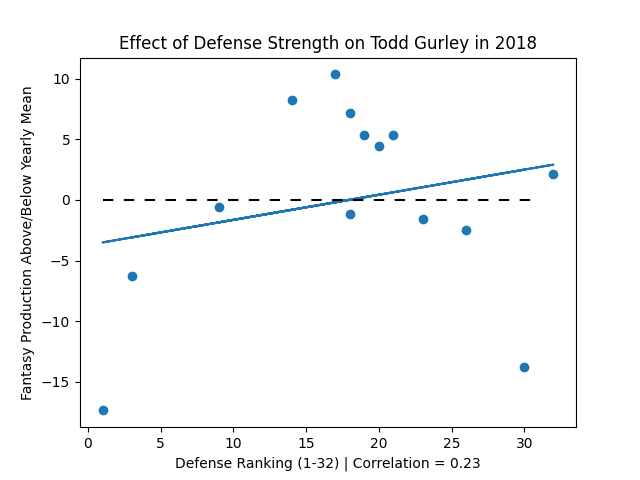
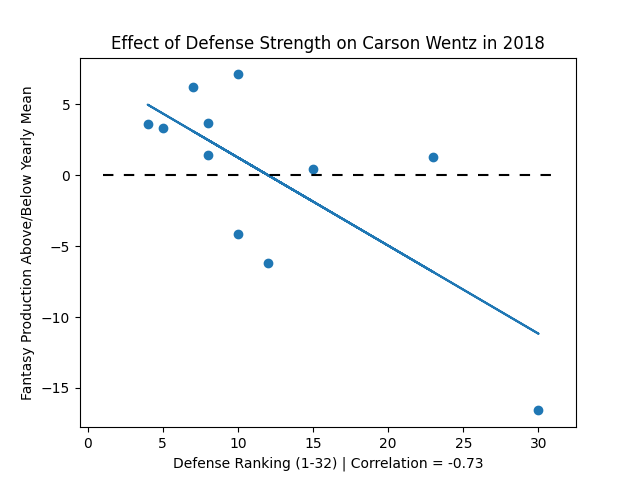
Todd Gurley was the highest fantasy scorer in 2018 and had little to no correlation between his fantasy output and the defense he played confronting. Surprisingly, Carson Wentz had a strong negative correlation between his fantasy output and the defense force he played against. This means that he played better against improve defenses. Although there is an outlier in his information, there is even so a somewhat articulate negative trend.
2019:
- Christian McCaffrey: 0.42 (#ane Overall Player)
- Tony Pollard: 0.62
- Eric Ebron: 0.63
- Andy Dalton: 0.64
- Tevin Coleman: 0.65
- Marquise Brown: 0.65
- Chris Carson: 0.67
- Jimmy Garoppolo: 0.68
- Alshon Jeffery 0.68
- Odell Beckham: 0.68
- Devonta Freeman: 0.71
- Melvin Gordon: 0.73
- Adam Thielen: 0.74
- Jared Goff: 0.79
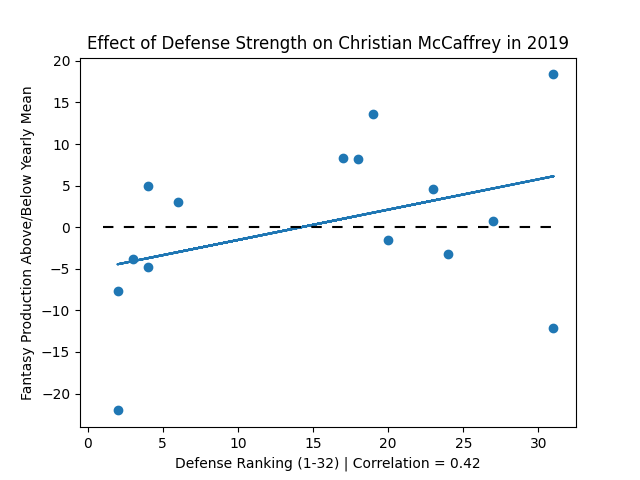
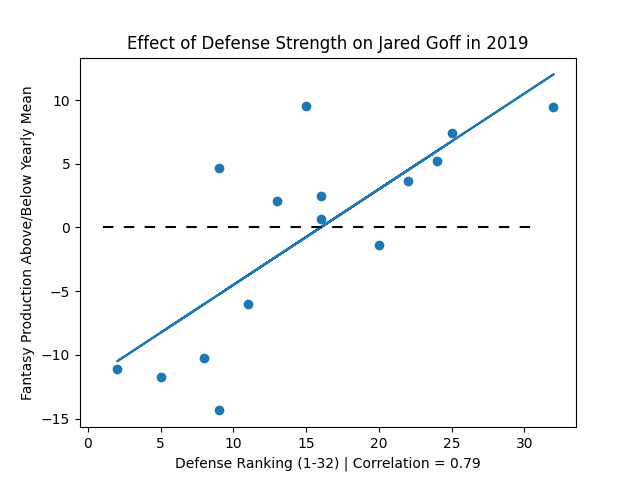
Christian McCaffrey scored the most fantasy points in 2019 and had a very slight correlation between his performance and the defense he played against. On the other paw, just like in 2017, Jared Goff had a very strong correlation between his functioning and the forcefulness of the defence force he played.
However, in football, many factors that become into how a histrion plays other than the defense they're playing. Simply to name a few: game script, injuries, coaching, etc. Although some of these numbers may seem disarming, many many other factors are playing a role.
This was my offset time using pandas, numpy, and matplotlib in Python. You can cheque out my code on Github.
Let me know if you have any feedback. Thanks!
DOWNLOAD HERE
Posted by: brockmanunat1969.blogspot.com
